You are using an out of date browser. It may not display this or other websites correctly.
You should upgrade or use an alternative browser.
You should upgrade or use an alternative browser.
Early submarine (1700 to 1900) unbuilt project ?
- Thread starter pacino
- Start date
this page has alot of what your after but mostly American civil war .deep storm has alot on russian subs. [http://www.navyandmarine.org/alligator/underwaterprints.htm/url]
It only just fits the bracket, but GW Hovgaard designed a submarine for the Royal Danish Navy in 1900.
http://www.majhost.com/cgi-bin/gallery.cgi?f=243261
http://www.majhost.com/cgi-bin/gallery.cgi?f=243261
- Joined
- 11 March 2006
- Messages
- 8,667
- Reaction score
- 3,528
Indeed very interesting, didn't know about it before, though quite well documented,
e.g. here http://nauticalarch.org/projects/sub-marine-explorer-survey/ and
even on wiki https://en.wikipedia.org/wiki/Sub_Marine_Explorer.
Seems to have been quite an advance compared to the much more famous near contemporaries Brandtaucher and Seeteufel
by Wilhelm Bauer.
e.g. here http://nauticalarch.org/projects/sub-marine-explorer-survey/ and
even on wiki https://en.wikipedia.org/wiki/Sub_Marine_Explorer.
Seems to have been quite an advance compared to the much more famous near contemporaries Brandtaucher and Seeteufel
by Wilhelm Bauer.
http://www.sciencechannel.com/tv-shows/impossible-engineering/impossible-engineering-videos/this-island-is-hiding-an-incredible-submarine-wreck/?utm_campaign=trueAnthem%3A+Trending+Content&utm_content=59228c7219694a000814257c&utm_medium=trueAnthem&utm_source=facebook/b
seem's to have deteriorated quit a bit since it was identified by Delgado . i guess the wrong sorts found out where it was.
seem's to have deteriorated quit a bit since it was identified by Delgado . i guess the wrong sorts found out where it was.
Bottleship
ACCESS: Secret
- Joined
- 30 June 2019
- Messages
- 484
- Reaction score
- 1,231
Russian project between 1799-1900 years (in Russian):
 www.deepstorm.ru
I think, most interesting project of this period - Shestunov 1877-1879 sumbarine:
www.deepstorm.ru
I think, most interesting project of this period - Shestunov 1877-1879 sumbarine:
"Шестунов Николай Яковлевич. Инженер-механик флота. В 1879 г. разработал проект подводной лодки водоизмещением 1680 т при длине 67 м и диаметре веретенообразного корпуса 8,5 м. Подал идею подразделять корпус лодки на ярусы. Двигатель для подводного хода — два электромотора (с питанием от гальванических элементов), приводивших в действие мощные насосы водометного движителя. В оконечностях лодки имелось по две водопроточные трубы, в которые насосы засасывали забортную воду через приемные отверстия и выбрасывали обратно за борт — через выкидные сопла. Водомет использовался также для управления лодкой в горизонтальной плоскости и по глубине. Внутренний объем лодки подразделялся двумя палубами на три яруса. В верхнем ярусе размещались вдувной и вытяжной вентиляторы для перемешивания воздуха внутри лодки на подводном ходу, автоматический прибор для регенерации воздуха и другие вспомогательные механизмы; в среднем — офицерские каюты и другие помещения; в нижнем — кубрики команды,аккумуляторные батареи и электромоторы. Над средней частью корпуса имелась небольшая цилиндрическая рубка со смотровыми иллюминаторами."
Google-translator:
"Shestunov Nikolay Yakovlevich. Fleet Mechanical Engineer. In 1879, he developed a project for a submarine with a displacement of 1,680 tons with a length of 67 m and a diameter of a spindle-shaped hull of 8.5 m. He proposed the idea of dividing the hull of a boat into tiers. The underwater engine is two electric motors (powered by galvanic cells) that drive the powerful pumps of the water-jet propulsion. At the ends of the boat there were two water flow pipes, into which the pumps sucked outboard water through the inlet openings and threw it back overboard - through the discharge nozzles. The water cannon was also used to control the boat in a horizontal plane and in depth. The internal volume of the boat was divided by two decks into three tiers. In the upper tier there were inflatable and exhaust fans for mixing air inside the boat underwater, an automatic device for air regeneration and other auxiliary mechanisms; on average, officer cabins and other rooms; in the bottom - the team’s cockpits, batteries and electric motors. Above the middle part of the hull there was a small cylindrical wheelhouse with viewing portholes."
True Russian Nautilus))) With captain Nemoff))
From this:
Earliest Russian submarines - XVII century submarine of Zaporozhian Cossacks, and project of Efim Nikonov, 1718-1728.
Øòóðì Ãëóáèíû - Íåðåàëèçîâàííûå ïðîåêòû ïîäâîäíûõ ëîäîê 1799-1900ãã.
"Шестунов Николай Яковлевич. Инженер-механик флота. В 1879 г. разработал проект подводной лодки водоизмещением 1680 т при длине 67 м и диаметре веретенообразного корпуса 8,5 м. Подал идею подразделять корпус лодки на ярусы. Двигатель для подводного хода — два электромотора (с питанием от гальванических элементов), приводивших в действие мощные насосы водометного движителя. В оконечностях лодки имелось по две водопроточные трубы, в которые насосы засасывали забортную воду через приемные отверстия и выбрасывали обратно за борт — через выкидные сопла. Водомет использовался также для управления лодкой в горизонтальной плоскости и по глубине. Внутренний объем лодки подразделялся двумя палубами на три яруса. В верхнем ярусе размещались вдувной и вытяжной вентиляторы для перемешивания воздуха внутри лодки на подводном ходу, автоматический прибор для регенерации воздуха и другие вспомогательные механизмы; в среднем — офицерские каюты и другие помещения; в нижнем — кубрики команды,аккумуляторные батареи и электромоторы. Над средней частью корпуса имелась небольшая цилиндрическая рубка со смотровыми иллюминаторами."
Google-translator:
"Shestunov Nikolay Yakovlevich. Fleet Mechanical Engineer. In 1879, he developed a project for a submarine with a displacement of 1,680 tons with a length of 67 m and a diameter of a spindle-shaped hull of 8.5 m. He proposed the idea of dividing the hull of a boat into tiers. The underwater engine is two electric motors (powered by galvanic cells) that drive the powerful pumps of the water-jet propulsion. At the ends of the boat there were two water flow pipes, into which the pumps sucked outboard water through the inlet openings and threw it back overboard - through the discharge nozzles. The water cannon was also used to control the boat in a horizontal plane and in depth. The internal volume of the boat was divided by two decks into three tiers. In the upper tier there were inflatable and exhaust fans for mixing air inside the boat underwater, an automatic device for air regeneration and other auxiliary mechanisms; on average, officer cabins and other rooms; in the bottom - the team’s cockpits, batteries and electric motors. Above the middle part of the hull there was a small cylindrical wheelhouse with viewing portholes."
True Russian Nautilus))) With captain Nemoff))
From this:
Earliest Russian submarines - XVII century submarine of Zaporozhian Cossacks, and project of Efim Nikonov, 1718-1728.
Bottleship
ACCESS: Secret
- Joined
- 30 June 2019
- Messages
- 484
- Reaction score
- 1,231
From Russian book, "History of submarines. 1624-1904", A. E. Taras:
Demountable submarine from treatise of Roberto Valturio, with rotating paddles on crankshafts, 1472:

...
Concept of Leonardo da Vinci, 1502:

...
Submarine from book "Inventions or Devices, very necessary for all Generalles and Captaines, or Leaders of Men, as well by Sea and by Land", William Bourne, 1578:

...
Van Drebbel "underwater galley", 1624:

Depth to 12-15 foot, range to 6 Dutch miles (6 x 7.407 km, 44.44 km, or 24 standart marine miles). Tested a anti-ship powder "petard", "making a hole with a diameter of 15-16 foot" (4.572-4.877 metres), with impact fuze. In June 1626, British fleet ordered van Drebbel to make a "360 wrought shells with powder, 50 water mines and 290 water petards".
...
De Son (French engineer, for Holland) ram submarine, with paddle wheel and spring, 1654:

...
Denis Papin metal submarine, 1692 (reconstruction of A. E. Taras):

1 and 5 - hatches (5 - for hand), 2 - snorkels, 4 - paddle, 3 - tube for drill or powder mine.
Demountable submarine from treatise of Roberto Valturio, with rotating paddles on crankshafts, 1472:
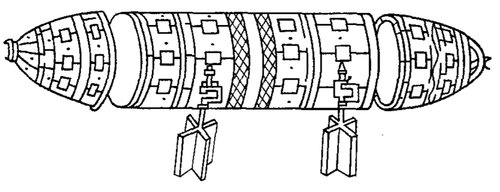
...
Concept of Leonardo da Vinci, 1502:
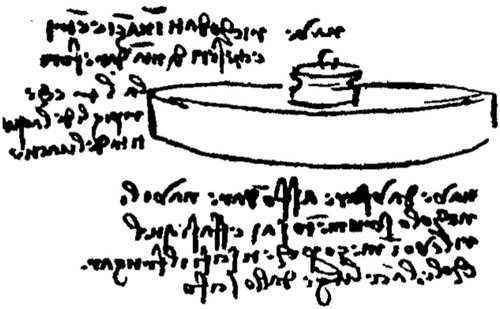
...
Submarine from book "Inventions or Devices, very necessary for all Generalles and Captaines, or Leaders of Men, as well by Sea and by Land", William Bourne, 1578:
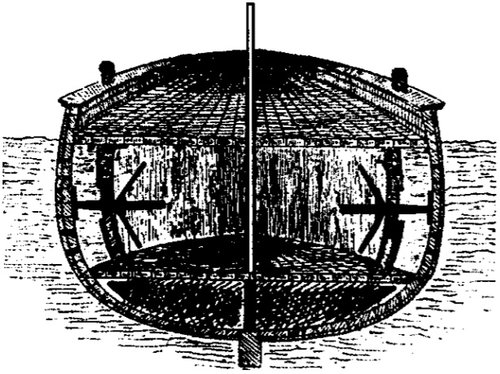
...
Van Drebbel "underwater galley", 1624:
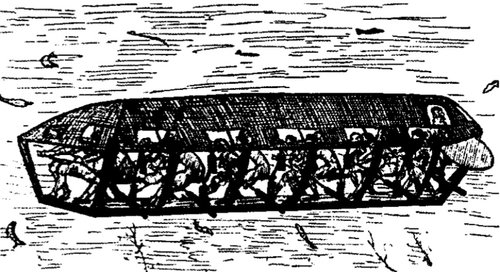
Depth to 12-15 foot, range to 6 Dutch miles (6 x 7.407 km, 44.44 km, or 24 standart marine miles). Tested a anti-ship powder "petard", "making a hole with a diameter of 15-16 foot" (4.572-4.877 metres), with impact fuze. In June 1626, British fleet ordered van Drebbel to make a "360 wrought shells with powder, 50 water mines and 290 water petards".
...
De Son (French engineer, for Holland) ram submarine, with paddle wheel and spring, 1654:

...
Denis Papin metal submarine, 1692 (reconstruction of A. E. Taras):
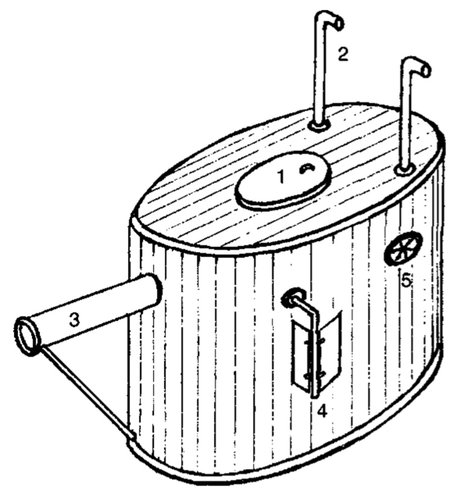
1 and 5 - hatches (5 - for hand), 2 - snorkels, 4 - paddle, 3 - tube for drill or powder mine.
